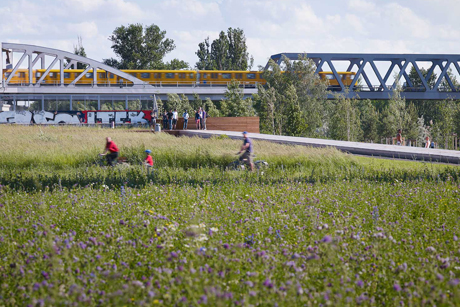Atelier Loidl Landschaftsarchitekten
Neubau der Zentrale der Bayerischen Versorgungskammer

(c) David Chipperfield Architects, Atelier Loidl Landschaftsarchitekten
David Chipperfield Architects Berlin, in collaboration with the landscape architects Atelier Loidl, has won the competition to design a new headquarters for the Bayerische Versorgungskammer in Munich's Bogenhausen district. The building is to be erected on the former Siemens site on Richard-Strauss-Straße. The proposal prevailed against eleven other submissions, with the jury impressed by the clear formal language and the highly flexible floor plans. The urban planning and use of landscape to integrate the building into its surroundings were also crucial factors in the decision.
The winning design features a sculptural ensemble made up of three large volumes. A tall tower is complemented by a connecting building wing and a lower tower. While the tower situated on the street provides a counterpart to the existing high-rise buildings, the open ground floor creates a flowing transition to the adjacent park. The delicate structure remains visible through the building’s fully glazed façade, creating an intriguing sense of depth.
In the Munich district of Bogenhausen a new headquarters for the Bayerische Versorgungskammer is to be built on a former production site of the Siemens company. The proposal by David Chipperfield Architects Berlin with Atelier Loidl is for a sculptural ensemble consisting of three large volumes. A tall tower is complemented by a connecting wing and a lower tower. While the taller tower complements the existing high-rise buildings along the street, the open design of the ground floor creates a fluent transition to the Denninger Anger, a park to the east of the property.The building uses a slender construction, which rises above a concrete base. The structure remains visible through the building’s fully glazed façade creating an intriguing sense of depth. Two public squares give structure to the extensive site, designed to resemble the clearings in the adjacent park. The urban, street-side square acts as a representative entrance area, while the planted square adjacent to the park features circumferential seating and can be used for various activities and events. A covered outdoor space under the elongated building, links the squares and allows a flowing transition through the property. The dense sequencing of columns allows for a flexible use of the floor plans. While the floors in the two tower buildings serve as office space, conference rooms are located in the spacious, high-ceilinged rooms in the bar building. Public uses such as a restaurant, a customer centre and a day-care centre can be found at park and street level while at the top of the building roof gardens offer wide views over the city and to t he Alps.
The winning design features a sculptural ensemble made up of three large volumes. A tall tower is complemented by a connecting building wing and a lower tower. While the tower situated on the street provides a counterpart to the existing high-rise buildings, the open ground floor creates a flowing transition to the adjacent park. The delicate structure remains visible through the building’s fully glazed façade, creating an intriguing sense of depth.
In the Munich district of Bogenhausen a new headquarters for the Bayerische Versorgungskammer is to be built on a former production site of the Siemens company. The proposal by David Chipperfield Architects Berlin with Atelier Loidl is for a sculptural ensemble consisting of three large volumes. A tall tower is complemented by a connecting wing and a lower tower. While the taller tower complements the existing high-rise buildings along the street, the open design of the ground floor creates a fluent transition to the Denninger Anger, a park to the east of the property.The building uses a slender construction, which rises above a concrete base. The structure remains visible through the building’s fully glazed façade creating an intriguing sense of depth. Two public squares give structure to the extensive site, designed to resemble the clearings in the adjacent park. The urban, street-side square acts as a representative entrance area, while the planted square adjacent to the park features circumferential seating and can be used for various activities and events. A covered outdoor space under the elongated building, links the squares and allows a flowing transition through the property. The dense sequencing of columns allows for a flexible use of the floor plans. While the floors in the two tower buildings serve as office space, conference rooms are located in the spacious, high-ceilinged rooms in the bar building. Public uses such as a restaurant, a customer centre and a day-care centre can be found at park and street level while at the top of the building roof gardens offer wide views over the city and to t he Alps.







